Technology
The McLaren P1 presents some unique technology
MonoCage

At the heart of the car is the carbon fibre MonoCage which serves as both the passenger compartment, the safety cell and the chassis’ major structural component. It’s a direct technology crossover from Formula 1™, made from fibres with more than five times the strength of top-grade titanium and twice the stiffness of steel. The entire MonoCage, including the roof, engine air-intake snorkel and integrated battery compartment for the IPAS system, weighs just 90kg.
IPAS

The Instant Power Assist System is a powerful electric motor integrated into the powertrain. The motor weighs just 26kg and produces 179PS – more than double the power of a Formula 1™ KERS unit. It boosts performance, whether deployed through the IPAS button on the steering wheel or working automatically, but it also dramatically sharpens throttle response by filling the torque gap as the V8’s twin turbochargers spool up.
History
Bruce McLaren

Bruce McLaren started his racing career as a teenager in an ingeniously modified Austin Ulster that his father gave him. A prodigiously talented engineer and racer, he developed his own Formula 1™ car in May 1966. It debuted at Monaco and qualified in 10th place with Bruce at the wheel. In the British Grand Prix two months later, McLaren Racing scored its first point in a Formula 1™ Grand Prix when Bruce finished sixth.
Tragically, Bruce died while testing the McLaren M8D at Goodwood in 1970. His death was a devastating blow. In memory of Bruce, racing legend Denny Hulme won nine out of 10 Can-Am races in the M8D in 1970. Wins in the Indy 500 followed for McLaren in 1972, 1974 and 1976. Under the control of Teddy Mayer, McLaren took the Formula 1™ constructor’s championships in 1974, and driver’s titles with Emerson Fittipaldi and, even more memorably, James Hunt.
Iconic road cars

Drawing on 50 years of racing success, McLaren has created some of the most iconic and exhilarating road cars the world has ever seen. During the epochal 1988 season, Team Principal Ron Dennis and Technical Director Gordon Murray began pondering the ultimate road car, a McLaren road car. In 1993 the seminal McLaren F1 was launched. Two years later, the F1 GTR dominated the podium at Le Mans, turning the greatest supercar of its generation into the most successful British race car of modern times.
DO NOT ADD
Legacy
675LT Spider
The McLaren 675LT (where "LT" stands for Long Tail) is a lightweight, track-focused evolution of the McLaren 650S. The 675LT Spider refers to the convertible form of the 675LT. It is 100 kgs lighter than the 650S Spider on which it is based and adds 40% more downforce. This results in reaching 200 km/h in just 8.1 seconds.






